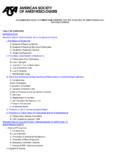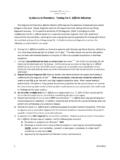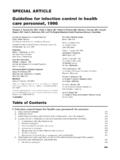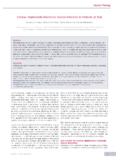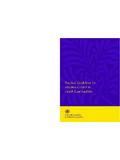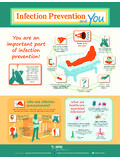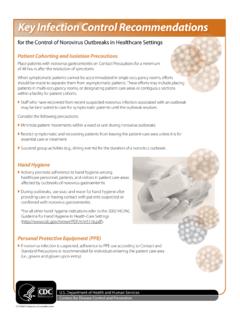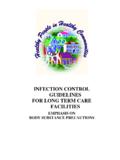Transcription of 14 Hospital hygiene and infection control
1 Safe management of wastes from health-care activities14814 Hospital hygiene andinfection ObjectiveManagement of health-care waste is an integral part of Hospital hygieneand infection control . Health-care waste should be considered as a reser-voir of pathogenic microorganisms, which can cause contamination andgive rise to infection . If waste is inadequately managed, these microor-ganisms can be transmitted by direct contact, in the air, or by a va-riety of vectors. Infectious waste contributes in this way to the risk ofnosocomial infections , putting the health of Hospital personnel, and pa-tients, at risk. The practices described in Chapters 6 to 10 of this hand-book for the proper management of health-care waste should therefore bestrictly followed as part of a comprehensive and systematic approach tohospital hygiene and infection chapter outlines the basic principles of prevention and control of theinfections that may be acquired in health-care facilities (but does notaddress other aspects of Hospital hygiene and safety such as pressuresores and the risk of falls).
2 It should be stressed here that other environ-mental health considerations, such as adequate water-supply and sanita-tion facilities for patients, visitors, and health-care staff, are of Epidemiology of nosocomial infectionsNosocomial infections known also as Hospital -acquired infections , Hospital -associated infections , and Hospital infections are infectionsthat are not present in the patient at the time of admission to hospitalbut develop during the course of the stay in Hospital . There are twoforms: Endogenous infection , self- infection , or auto- infection . The causativeagent of the infection is present in the patient at the time of admissionto Hospital but there are no signs of infection . The infection developsduring the stay in Hospital as a result of the patient s alteredresistance. Cross-contamination followed by cross- infection . During the stay inhospital the patient comes into contact with new infective agents,becomes contaminated, and subsequently develops an there is no clinically significant difference between the endogenousself- infection and the exogenous cross- infection , the distinction is impor-tant from the standpoint of epidemiology and people are naturally contaminated.
3 Faeces contain about 1013bacteria per gram, and the number of microorganisms on skin variesbetween 100 and 10000 per cm2. Many species of microorganisms liveHospital hygiene and infection control149on mucous membranes where they form a normal flora. None of thesetissues, however, is infected. Microorganisms that penetrate the skin orthe mucous membrane barrier reach subcutaneous tissue, muscles,bones, and body cavities ( peritoneal cavity, pleural cavity, bladder),which are normally sterile ( contain no detectable organisms). If ageneral or local reaction to this contamination develops, with clinicalsymptoms, there is an The transition from contamination to infectionWhether or not a tissue will develop an infection after contaminationdepends upon the interaction between the contaminating organisms andthe individuals have a normal general resistance to with underlying disease, newborn babies, and the elderly haveless resistance and will probably develop an infection after contamina-tion.
4 Health-care workers are thus less likely to become infected resistance of the tissue to infection also plays an important role: theskin and the mucous membranes act as barriers in contact with theenvironment. infection may follow when these barriers are resistance may also be overcome by the long-term presence of anirritant, such as a cannula or catheter; the likelihood of infection in-creases daily in a patient with an indwelling most important determinants of infection , however, are the natureand number of the contaminating organisms. Microorganisms rangefrom the completely innocuous to the extremely pathogenic: the formerwill never cause an infection , even in immunocompromised individuals,while the latter will cause an infection in any case of contamination. Aclassification of conventional, conditional, and opportunistic pathogens isgiven in Box only a few organisms are present on or in a tissue, an infection willnot necessarily develop.
5 However, when a critical number is exceeded,it is very likely that the tissue will become infected. For every type ofmicroorganism, the minimal infective dose can be determined; this is thelowest number of bacteria, viruses, or fungi that cause the first clinicalsigns of infection in a healthy individual. For most causative agents ofnosocomial infections , the minimal infective dose is relatively high. ForKlebsiella and Serratia spp. and other Enterobacteriaceae, for example,it is more than 100000, but for hepatitis B virus it is less than The sources of infectionIn a health-care facility, the sources of infection , and of the precedingcontamination, may be the personnel, the patients, or the Hospital environment can be contaminated with pathogens. Salmo-nella or Shigella spp., Escherichia coli O157:H7, or other pathogens maybe present in the food and cause an outbreak of disease just as they canin a community outside the Hospital . If the water distribution systembreaks down, waterborne infections may develop.
6 In more sophisticatedpremises the water cooling system of air conditioning equipment maySafe management of wastes from health-care activities150become contaminated with Legionella pneumophilia, causing Legion-naires disease in susceptible patients. Pharmaceuticals may becomecontaminated during production or preparation; an outbreak of infectionwith, for example, Pseudomonas aeruginosa, Burkholderia cepacia, orSerratia marcescens, may occur as a consequence. In all these examples,it may be possible to isolate the same causative agent in several patients,which would suggest a common source. All possible measures should betaken to prevent the recurrence of such source of an outbreak of nosocomial infection may also be a healthworker who is infected or colonized (a carrier). The symptoms of frankinfection will make the potential of transmission apparent to the healthworker and/or to managerial staff, and infected personnel are usuallydismissed from patient care duties.
7 A symptomless carrier, however, iscontaminated or colonized by potentially pathogenic organisms but doesnot develop any infection . A typical example is Staphylococcus aureus,which may be carried in the nasal passages of 30 60% of carriage of enteropathogens such as Salmonella spp. also occursfrequently, but the prevalence varies according to the region. Otherconventional pathogens that can be found in symptomless carriersinclude Streptococcus pyogenes, Corynebacterium diphtheriae, Neisseriameningitidis, hepatitis B virus, and cytomegalovirus. Contamination ofpatients by carriers can give rise to an outbreak of disease. Carefulinvestigation and isolation of the same organisms from a cluster ofpatients should reveal the cause of the Classification of pathogenic germs1 Conventional pathogensCause disease in healthy individuals in the absence of specific :Staphylococcus aureus, Streptococcus pyogenes, Salmonella spp.
8 , Shigellaspp., Corynebacterium diphtheriae, Mycobacterium tuberculosis, Bordetellapertussis, hepatitis A and B viruses, rubella virus, rotaviruses, human immuno-deficiency virus (HIV).Conditional pathogensCause disease, other than trivial local infections , only in persons with reducedresistance to infection (including newborn infants) or when implanted directly intotissue or a normally sterile body :Streptococcus agalactiae, Enterococcus spp., Clostridium tetani, Escherichiacoli, Klebsiella spp., Serratia marcescens, Acinetobacter baumanii, Pseudomo-nas aeruginosa, Candida pathogensCause generalized disease, but only in patients with profoundly diminished resis-tance to :atypical mycobacteria, Nocardia asteroides, Pneumocystis : Parker (1978). Hospital hygiene and infection control151 The source of most Hospital epidemics is infected patients, patientscontaminated with pathogenic microorganisms. These microorganismsare often released into the environment in very high numbers, exceedingthe minimal infective dose, and contaminate other patients who subse-quently develop Hospital -acquired The routes of transmissionMicroorganisms can be transmitted from their source to a new hostthrough direct or indirect contact, in the air, or by transmission is typical of countries in which insects,arthropods, and other parasites are widespread.
9 These become contami-nated by contact with excreta or secretions from an infected patient andtransmit the infective organisms mechanically to other transmission occurs only with microorganisms that are dis-persed into the air and that are characterized by a low minimal infectivedose. Only a few bacteria and viruses are present in expired air, andthese are dispersed in large numbers only as a result of sneezing contact between patients does not usually occur in health-carefacilities, but an infected health-care worker can touch a patient anddirectly transmit a large number of microorganisms to the new most frequent route of transmission, however, is indirect infected patient touches and contaminates an object, an instru-ment, or a surface. Subsequent contact between that item and anotherpatient is likely to contaminate the second individual who may thendevelop an general care and/or medical treatment, the hands of health-careworkers often come into close contact with patients.
10 The hands of theclinical personnel are thus the most frequent vehicles for nosocomialinfections. Transmission by this route is much more common than vector-borne or airborne transmission or other forms of direct or spread of nosocomial infections is summarized and illustrated inFig. The prevention of nosocomial PrinciplesTwo basic principles govern the main measures that should be takenin order to prevent the spread of nosocomial infections in health-carefacilities: separate the infection source from the rest of the Hospital ; cut off any route of separation of the source has to be interpreted in a broad sense. Itincludes not only the isolation of infected patients but also all aseptictechniques the measures that are intended to act as a barrier betweenSafe management of wastes from health-care activities152infected or potentially contaminated tissue and the environment, includ-ing other patients and recent years, increasing attention has been paid to the protection ofthe personnel, in particular against the transmission of bloodborne infec-tions, AIDS and viral hepatitis B and C.










